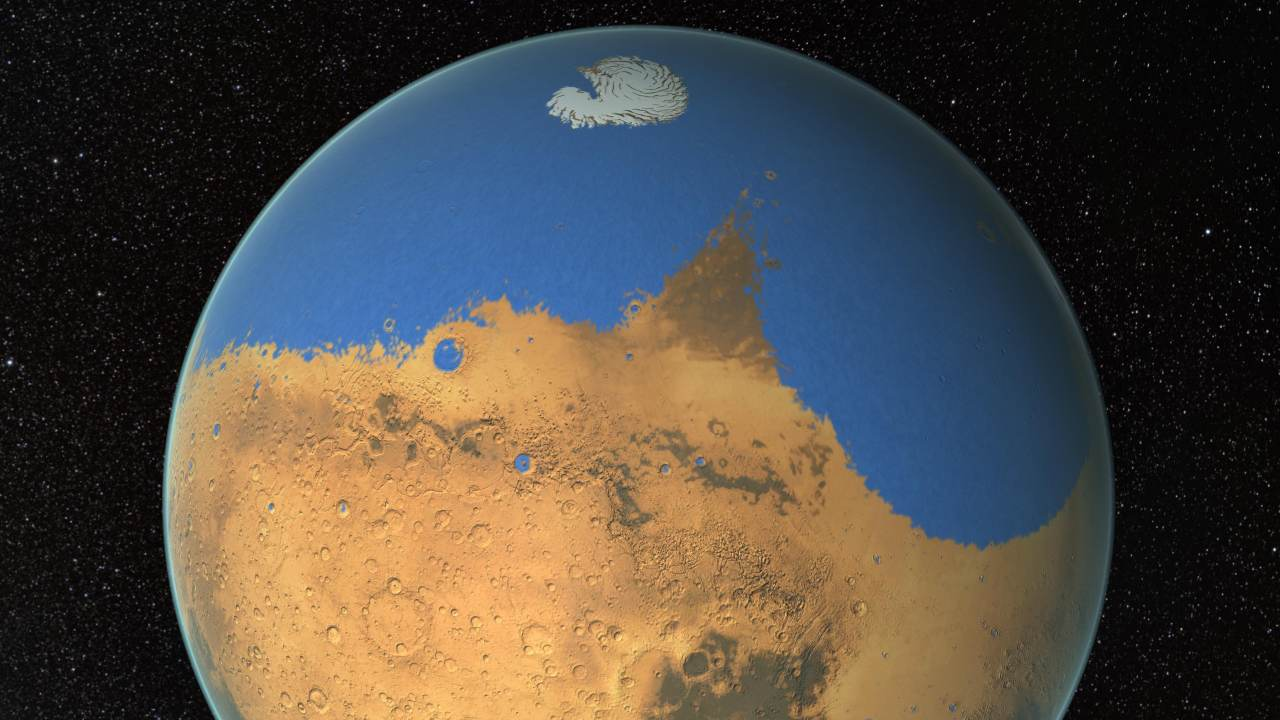Atmospheric escape: Why Earth will eventually resemble Mars
Julia Nwokedi. 05/15/2021
![]()
For as long as humans have studied astronomy, Mars has been defined by its reddish-orange hue. However, recent scientific discovery has noted that Mars closely resembled Earth billions of years ago, with lakes, rivers, seas, oceans and perhaps even life. And due to gradual processes that are taking place right now, Earth will closely resemble Mars in the distant future.
The hue on Mars is a product of natural chemical processes. Mars is a terrestrial planet, composed of silicate rocks and metals. All metals are susceptible to a chemical process known as corrosion, which happens through oxidation. In chemistry, oxidation is the loss of electrons during a chemical reaction, and reduction is the complementary gain of electrons. When metals are oxidized, they corrode and become a reddish-orange hue. For example, iron is oxidized by water and oxygen, creating rust:
4Fe + 3O2 + 6H2O → 4Fe(OH)3
All metals are electropositive and are disposed to losing electrons in a chemical reaction. Therefore, corrosion puts metals in their most natural and chemically stable state, and all metals—including stainless steel or silver—are susceptible to a type of corrosion at some point. This also means that terrestrial planets, composed of metal, are susceptible to corrosion.
On a much larger scale, atmospheric escape plays a major role in Mars’ hue. Atmospheric escape is a natural planetary process in which atmospheric gases are lost to outer space. The driving factor of atmospheric escape is heat; as gases are heated, they expand. Atmospheres are bound only by gravity, and at 5,778 K (9,941°F), the Sun provides more than enough heat to lift an atmosphere away from its planet. Through deep analysis of the Martian surface, planetary scientists have come to a consensus that Mars used to be full of water, which explains how it dried out and corroded. At high enough temperatures, water can break down into hydrogen and oxygen. Hydrogen has the lowest atomic weight of all elements and can therefore easily escape into the atmosphere and then into space. Oxygen, almost 16 times heavier, expands into space at a much slower rate. Therefore, while hydrogen was escaping from Mars, oxygen remained on the surface for a bit and oxidized the surface of Mars. The data correspond—the Martian crust, corroded from oxidization, is composed of iron, magnesium, aluminum, calcium and potassium, along with oxygen and silicon.

Despite also being a terrestrial planet with an abundance of water, Earth has not corroded. Two major factors that explain this are gravity and magnetism. The gravity of an object is determined by its mass, and the magnetism is determined by its electric currents. Mars lacks a global magnetic field, and due to its mass, only has 38% of Earth’s gravitational pull, so it can’t grip onto its atmosphere quite as effectively as Earth can. Still, Earth’s atmosphere is constantly being pulled away from its surface. In a few billion years, however, external factors will create the ideal environment for Earth’s corrosion.
Each star, including our Sun, is powered through nuclear fusion of hydrogen and helium gas in its core. Nuclear fusion releases substantial amounts of energy, which causes a star to expand, but due to expanding, it loses density, cools down and compresses, causing it to release more energy again. These complementary and spontaneous reactions help stars remain in equilibrium, with a persistent size and shape, until they eventually run out of hydrogen and die. However, stars are not in an equilibrium of heat. According to the University of Southern Maine, “As the Sun ages, it slowly grows hotter due to the accumulation of residual energy emitted by these core reactions.” When the Sun’s heat becomes more intense, the rate of atmospheric escape will increase, and atmospheric escape on Earth will finally be rapid enough to create another dry, corroded planet. The intense heat, absence of water and thin atmosphere will cause life on Earth to come to a halt. Fortunately, this process will only occur in a few billion years.
Although the impacts of atmospheric escape will only be seen on Earth in the distant future, atmospheric escape itself is actively occurring. It is actively occurring on Mars, on exoplanets, but most relevantly, on planet Earth. Wherever there’s a planet in a solar system, there’s atmospheric escape, and that includes Earth with all its uniqueness and vitality. Outer space is not distant from Earth, but rather it encompasses Earth, and so do its laws. Earth, a planet set apart by its unique ability to contain life, will eventually become another dry, lifeless, corroded planet. And Mars, a dry, lifeless, corroded planet, possibly contained ancient life. Once the Sun becomes a gas giant, Earth will become engulfed. So, while Earth is extraordinary, it isn’t quite extraordinary enough to resist the forces of outer space.
Cover Photo: (NASA)
